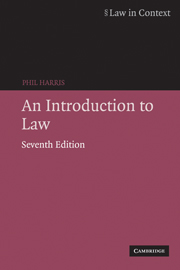Book contents
- Frontmatter
- Contents
- Preface
- Table of statutes
- Table of cases
- 1 Law and society
- 2 Law and morality
- 3 Law and the regulation of economic activity
- 4 Some important legal concepts
- 5 Law and property
- 6 Law and the settlement of disputes
- 7 The making of legal rules
- 8 The European dimension of English law
- 9 Liability in English law: the law of tort
- 10 Liability in English law: crime and the criminal justice system
- 11 The development and the role of the contract
- 12 Law and government
- 13 The legal profession
- 14 The judges
- Index
5 - Law and property
- Frontmatter
- Contents
- Preface
- Table of statutes
- Table of cases
- 1 Law and society
- 2 Law and morality
- 3 Law and the regulation of economic activity
- 4 Some important legal concepts
- 5 Law and property
- 6 Law and the settlement of disputes
- 7 The making of legal rules
- 8 The European dimension of English law
- 9 Liability in English law: the law of tort
- 10 Liability in English law: crime and the criminal justice system
- 11 The development and the role of the contract
- 12 Law and government
- 13 The legal profession
- 14 The judges
- Index
Summary
Legal rules are invariably related to social and economic conditions prevailing at a given period, and so we find that the legal normative expressions of the relationship between the holder of property rights and the objects of those rights have their basis in social and economic practice. We saw in chapter 3 the extent to which the law relating to business concerns itself predominantly with business property, and the regulation and transfer of that property, in accordance with the economic structure within which business operates, and we noted in chapter 2 the relationship between the law of theft and the demands of propertied classes for adequate legal protection of their property. Similarly, property concepts such as ownership and possession, leases and mortgages, contracts and trusts, are legal normative reflections of the economic activities and demands of individuals and classes at different periods.
In considering law and property, we must also bear in mind two further points. First, in our economic system, property rights are related to wealth, and when we speak of wealth and property we are usually implicitly acknowledging the unequal distribution of private property and property rights among social classes. Second, property is not treated in law as a homogeneous category. Because property objects have taken different forms and have represented differing degrees of value at different times, the law has developed a fairly specific classification of property, each type of which has particular legal rules attached to it.
- Type
- Chapter
- Information
- An Introduction to Law , pp. 110 - 149Publisher: Cambridge University PressPrint publication year: 2006

